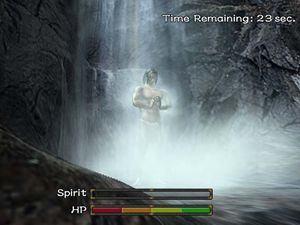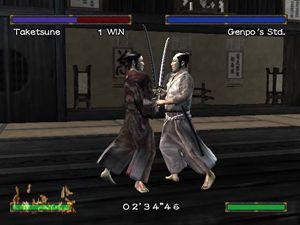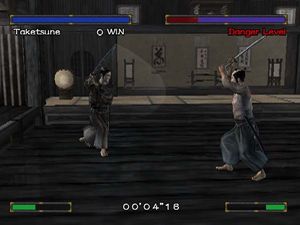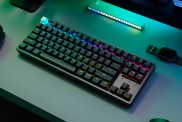Seppuku!
In 1997, I was but a grasshopper. When Bushido
Blade arrived at the doorstep of my quaint two-bedroom/one-bath dojo, I accepted
the review challenge with trepidation. Was I up to the task of handling such a
raw deviation from the standard fighting games I had previously reviewed? Could
I successfully complete a review while maintaining my honor, or would I disgrace
my family AND the Shaolin temple?
It was difficult, that’s for certain, as I was not allowed to stab my review
in the back nor hit it while it was down. But by adhering to the sacred and
mysterious laws of Bushido, I was able to finish my review while maintaining
my honor. It was a major step for gaming and an important milestone in my training.
Now it is 2001, and as an old, wizened master, I come to you with a tale of
great suffering, of great heartache. It is a tale of a game gone awry. It is
a tale of a game that has lost its honor. And I am the master who has been stabbed
in the back.
In truth, Kengo: Master of Bushido is just a ‘spirited’ sequel to the
Bushido Blade games on the original PSX. Still, it’s made by the same
developer and follows the same mold. But somehow, this warrior fails to deliver
the promise set up by the previous incarnations.
I should have known something was amiss when I decided to read the manual. Usually
this leads to a better understanding of the controls and whatnot, but in this
case it only clarified the first enormous mistake the developers made with Kengo.
I quote:
"Japan's Genroku Period was from 1688 to 1704. The age of bloody wars had ended and warriors could no longer make a name for themselves through battle. Yet there were still many who were fascinated by the master swordsman's way of life."
So in other words, what we have here is a samurai game taking place AFTER the
time when samurai were considered battlefield heroes. That’s sort of like making
a basketball game that takes place during the off-season. Why did they do this?
My best guess points to a potent combination of lead poisoning and lyme disease.
The single player game attempts to simulate the thrilling life of an intellectual
ex-samurai. Basically, you choose one of three characters, train him to be a
swordsman, pick fights with other schools to learn their techniques and eventually
enter a tournament to prove that you are a master.
Training involves typical off-season samurai activities such as chopping down
bamboo sticks, standing beneath a waterfall, meditating, and extinguishing candles
with your blade. Most involve button timing exercises and have very little mini-game
depth or appeal. Kind of neat at first, but they all get quite tedious and boring
after the 20th time.
As you challenge other schools, you acquire new moves. This leads to easily
the best part of the game – customizing forms.
In effect, you can choose three moves to turn into a combo, then set that
combo as one of the four trigger buttons. With 4 different styles programmed
into the triggers, you can really create a unique fighter. Additionally, beating
an opposing school will yield a sword. When equipped, the different swords each
have a specific ‘secret technique’ (ie. ‘Big Ass Move’).
For the most part, though, you actually fight with wooden swords, bokken
to be exact. You only use real steel swords in Tournaments and in a few grudge
matches. I feel gypped.
 In
In
addition to the single player game, you can check out Tournament mode (which
just lets you fight without care for the training) or play against a friend.
That’s it. No Survival mode, Team Battles, editable replays…nothing. This
skimpiness takes the whole ‘Zen ascetic’ thing a little too far.
The presentation is mixed. The fighters looks good and the actual sword strikes
are very cool, but movement in general is dumpy, with fighters sliding around
without moving their legs half the time. Very little effort went into character
design. The students you face when you challenge dojos all have identical faces.
Clone wars!
While the graphics are subpar, the voice acting is great. No dubbing here –
it’s all authentic Japanese with subtitles. Given, no one says anything interesting,
but still, props to the voices.
The fighting engine itself is awkward and unsatisfying. The game is in full
3D, but the camera doesn’t remain fixed and the control layout is relative to
your opponent. There is no auto-targeting, so you often wind up swinging at
thin air while your opponent is hacking air in the opposite direction. Compared
to Tekken Tag or DOA
2, this just isn’t remotely up to snuff.
The original Bushido Blade featured multi-tiered levels and open-ended
screens; you could fight in six different locations during one round. The second
game did away with the freedom of movement but kept in the multi-tiered
levels. Kengo hacks out even that last cool bit, featuring strictly dojo
fighting. Occasional matches right outside the dojo hardly counts.
For that matter, all the great concepts introduced in the original are gone. You cannot disable your opponent’s legs. There are no one-hit kills. There are no alternate weapons or throwing items. Even the rules of Bushido (which really helped the traditional flavor take root) have been tossed out. They took what could have been a revolutionary game and turned it into a bland, generic, below-average fighter.
Perhaps I expected too much. I was hoping for a samurai simulator that lets
you become Musashi Miyamoto, traveling the land looking for competition. I was
hoping for depth and ingenuity. I wanted Seven Samurai, but got Samurai
Deli.
Even if you never played the earlier Bushido Blade games, Kengo
pales next to the other fighting games for the PS2. I suppose it’s almost worth
a rental, though I’d recommend just watching Yojimbo
instead.

-
Cool customizable moves
-
Great voices
-
Only fight in dojos!
-
Weak engine
-
Bland graphics











